2019.03.29Field Report
Being a Part of the "AKARI" Bringing Light to People Project, Report by Volunteer Employee Reporters
2015.11.06 Field Report
Panasonic joined in the disaster recovery effort after super typhoon Haiyan (Yolanda) wreaked havoc on the Philippines in November 2013 by donating 1,002 solar lanterns to the Philippine Department of Social Welfare and Development (DSWD). Project member who visited the stricken region two years after the disaster filed this two-part report. Part one shares some first-hand experiences of people who witnessed the typhoon and the massive destruction left in its path.
Hello, this is Hisao Tsugita of the 100 Thousand Solar Lanterns Project.
I visited the city of Tacloban on the central island of Leyte in the Eastern Visayas region of the Philippines in early September of this year. The purpose was to see how the people were using the solar lanterns that we had supplied to the emergency relief effort.
Two years ago, the region was directly hit by super typhoon Haiyan (called Yolanda in the Philippines), and received tremendous damage with over 6,000 casualties and more than an estimated 1.1 million homes lost. The harbor city of Tacloban is also said to have been the hardest hit by the storm surge from the rising sea level caused by the 350 km/hr typhoon winds.
We were told that the city was making much progress with its reconstruction and that electricity was already available in the bunkhouses (temporary housing shelters). We thought it was very possible that the solar lanterns were no longer being used, so we were a little apprehensive about what we might find.
We visited the International Pharmaceuticals, Inc. (IPI) bunkhouses at one of the largest remaining camps of temporary housing for people displaced by the typhoon. Located about a 10-minute drive by car southeast from the center of Tacloban on a property a Philippine pharmaceutical company is providing free of charge for government use, people started moving into the newly constructed bunkhouses just three months after the typhoon. At its peak, the camp housed some 528 families and remains home for 442 families.
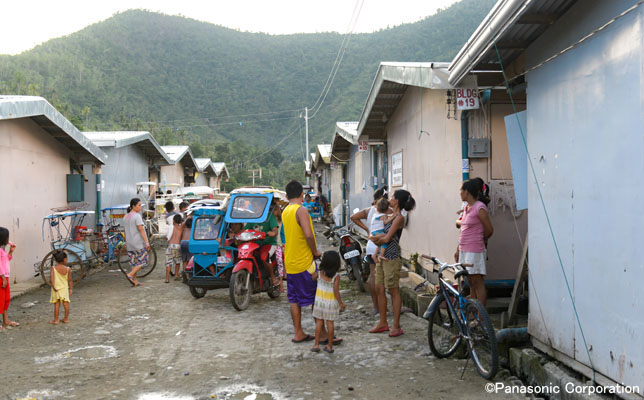
The tenement-type bunkhouses line both sides of "Main Street" and electric lines are also visible. When evening comes, lights flickered on inside the houses and outside in the streets. On first impression, it looked like there was plenty of light.
The bunkhouses are divided into 18-square-meter rooms and allocated to families based on the number of people: one room for a family with up to five people and two rooms for families of six or more. The houses are simple structures with wooden walls and corrugated tin roofs and, probably because of the heat, most of the doors and windows were open when we visited. The rooms are lit by bare light bulbs, which are bulb-shaped fluorescent lights. After dark, the camp is like a bustling town with people coming and going under the streetlights outside.
From how the camp looks now, it's difficult to imagine the devastation that remained immediately after the typhoon. We asked several of the residents to tell us about the experience living through the super typhoon.
The next morning, we visited the coastal areas to see for ourselves the damage caused by the typhoon. While driving there in the car, we saw a steel structure rising above the thickly growing weeds. It appeared to be the previous site of the town and when we got out of the car to look, we saw the traces of a residential area where only the foundations remained. Two hospitals and a hotel were the only structures that still had walls, and even those had parts of their roofs blown off. Needless to say, they are completely unusable now.
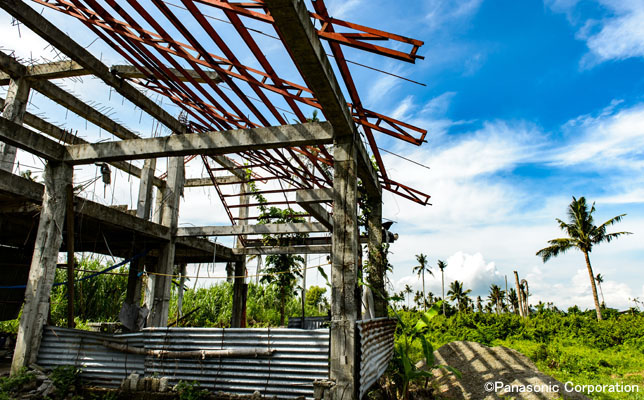
The skeletal remains of a house destroyed by the storm surge caused by typhoon Haiyan. All that remains is the frame.
Further on, we came upon a line of shacks built along the side of the road. All of the houses that were here had been washed away by the storm surge. A man doing carpentry work under the eaves of one of these shacks told us that they were built after the disaster. Then he started speaking in a soft voice as he told about staying inside his home as the typhoon made landfall.
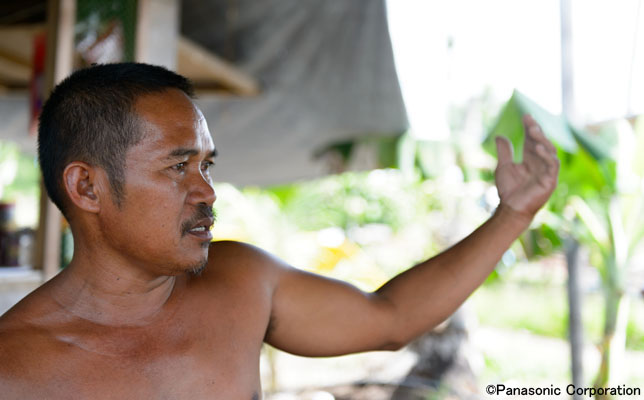
As one man recounted his story of clinging to a palm tree to survive his eyes welled and his voice turned tearful. He said his brothers were in their house when Haiyan hit. Fortunately, everyone in his family survived.
"I heard that the typhoon was going to be bigger than normal, but I never imagined it would cause such massive destruction. Just to be safe, I made my wife, who was holding our small child, go to the emergency shelter while I stayed home to protect our property. If they'd said a tidal wave was coming rather than saying it was storm surge, which I didn't fully understand at the time, I probably would've gone to the shelter too."
The storm surge caused the sea level to rise and a tidal wave also formed. This inundated the coastal area with the same destructive force as a tsunami. By the time he realized what a storm surge was, it was too late. He clung to a palm tree and held on for dear life against the rushing waves. The storm was blowing so hard that he couldn't even open his eyes to see what was happening around him. He said he had to hold his breath many times while waves swelled over his head.
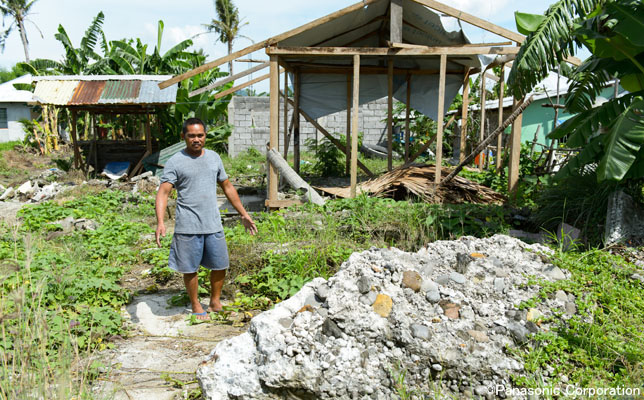
He brought us to where his home had been and showed us a section of concrete from the levee resting on the site. His home was gone without a trace.
Not even the shelters were safe from the storm in some cases.
Gina, a woman we met at the IPI bunkhouses, had also been living on the coast near the airport. She and her two children had evacuated to the elementary school the night before the typhoon hit. When the typhoon made landfall, however, the tidal waves reached to the top of the first floor of the school.
"The seawater suddenly rose up to the ceiling and we were still stuck inside. Somehow, I was able to break a window and escape, but I had to abandon my two children who were still in the room, otherwise all three of us probably would have died. It was impossible for me to get them out on my own. When the water receded, my daughter was miraculously still alive, still in the same place where I left her, holding on to a window ledge. My other child, who was only a baby, didn't survive."
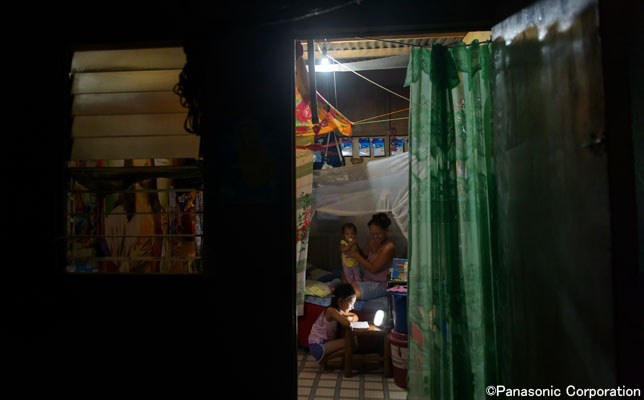
Gina comforts her baby, born after the storm, while helping her eldest daughter Jamaica do schoolwork.
I volunteer about twice a year in the reconstruction effort after the 2011 Tohoku earthquake and tsunami in Japan. The stories of the damage caused by typhoon Haiyan were very similar to those I have heard in the areas of Japan that were hit by the tsunami. Although storm surges and tsunami are triggered by different mechanisms, the storm surge from Haiyan uprooted and washed away a large part of Tacloban just like the tsunami washed away whole communities in Japan. In Tacloban, there are many accounts of people narrowly escaping disaster by clinging to the rubble. Even those who had evacuated to the safety shelters could not escape the storm. I heard similar stories in Tohoku.
Gina reunited with her husband and moved to the nearby university for shelter. The university, however, was not a designated evacuation area so they had to move again after spending just one night there. She returned to where her house had been and had no choice but to start living outside. For a month, her only respite came from sitting on a bench she made using wood gathered from a destroyed building until she obtained a tent from the United Nations High Commissioner for Refugees. (UNHCR)
"Whenever it rained, there was nothing we could do but get soaking wet."
To be continued in part two.
|
|